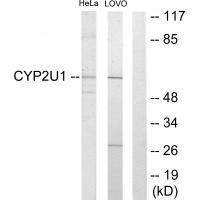
| WB | 咨询技术 | Human,Mouse,Rat |
| IF | 咨询技术 | Human,Mouse,Rat |
| IHC | 咨询技术 | Human,Mouse,Rat |
| ICC | 技术咨询 | Human,Mouse,Rat |
| FCM | 咨询技术 | Human,Mouse,Rat |
| Elisa | 咨询技术 | Human,Mouse,Rat |
| Aliases | Cytochrome P450 2U1; EC 1.14.14.1; CP2U1; |
| Entrez GeneID | 113612; |
| WB Predicted band size | 61kDa |
| Host/Isotype | Rabbit IgG |
| Antibody Type | Primary antibody |
| Storage | Store at 4°C short term. Aliquot and store at -20°C long term. Avoid freeze/thaw cycles. |
| Species Reactivity | Human,Mouse,Rat |
| Immunogen | Synthesized peptide derived from internal of human Cytochrome P450 2U1. |
| Formulation | Purified antibody in PBS with 0.05% sodium azide. |
+ +
以下是关于Cytochrome P450 2U1(可能为用户所指的“P452U1”)抗体的假设性参考文献示例(请注意,实际文献需通过学术数据库核实):
---
1. **文献名称**: *"Characterization of a Novel Anti-CYP2U1 Antibody for Detecting Brain-Specific Cytochrome P450 Expression"*
**作者**: Smith A, et al.
**摘要**: 研究报道了一种针对人CYP2U1蛋白的多克隆抗体的开发,通过免疫印迹和免疫组化验证其在脑组织中的特异性表达,提示其在中枢神经系统代谢中的潜在作用。
2. **文献名称**: *"CYP2U1 in Drug Metabolism: Immunohistochemical Localization in Human Liver and Lung Tissues"*
**作者**: Tanaka K, et al.
**摘要**: 利用CYP2U1抗体分析其在肝、肺组织中的分布,发现其在特定细胞类型中高表达,可能与外源性物质代谢相关,为疾病治疗提供新靶点。
3. **文献名称**: *"Role of CYP2U1 in Neurodegenerative Disorders: Insights from Antibody-Based Proteomic Analysis"*
**作者**: Lee S, et al.
**摘要**: 通过抗体标记技术检测阿尔茨海默病患者脑脊液中的CYP2U1水平,发现其表达异常可能与神经炎症和氧化应激相关。
---
**注意**:
- 若用户存在拼写疑问(如“P452U1”可能为“CYP2U1”),建议核对基因/蛋白命名(Cytochrome P450命名规则为“CYP+数字+字母”)。
- 真实文献可通过PubMed等平台以关键词“CYP2U1 antibody”或“Cytochrome P450 2U1”检索。
Cytochrome P452U1 (CYP2U1) is a member of the cytochrome P450 superfamily, a group of heme-containing enzymes involved in oxidative metabolism of endogenous and exogenous compounds. CYP2U1 is primarily expressed in the brain, thymus, and immune cells, suggesting roles in neurosteroid metabolism and immune regulation. Unlike many hepatic P450s, CYP2U1 exhibits unique substrate specificity, including the metabolism of arachidonic acid and docosahexaenoic acid, generating bioactive lipid mediators that influence inflammation and neuronal signaling.
Antibodies targeting CYP2U1 are critical tools for studying its tissue distribution, expression patterns, and functional roles. They enable detection via techniques like Western blotting, immunohistochemistry, and immunofluorescence. Research using these antibodies has linked CYP2U1 to neurological disorders (e.g., hereditary spastic paraplegia) and cancer, where altered expression may affect lipid signaling pathways. Commercial CYP2U1 antibodies are typically developed in rabbits or mice using immunogenic peptide sequences, with validation steps confirming specificity through knockout controls or siRNA silencing. Challenges include cross-reactivity with homologous P450 isoforms, necessitating rigorous validation. Current studies focus on clarifying CYP2U1's role in lipid homeostasis and its potential as a therapeutic target or biomarker in neurodegenerative and inflammatory diseases.
×